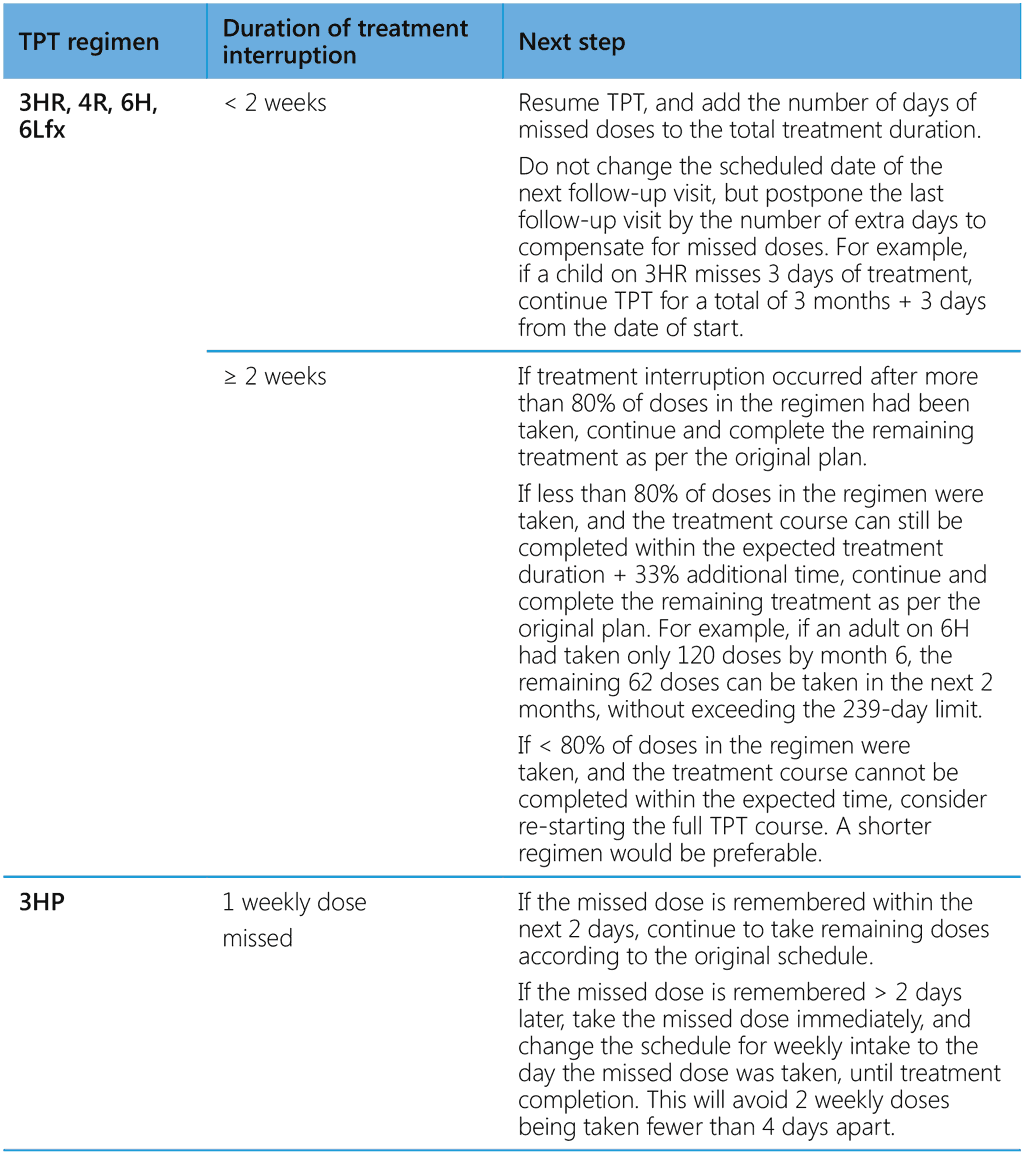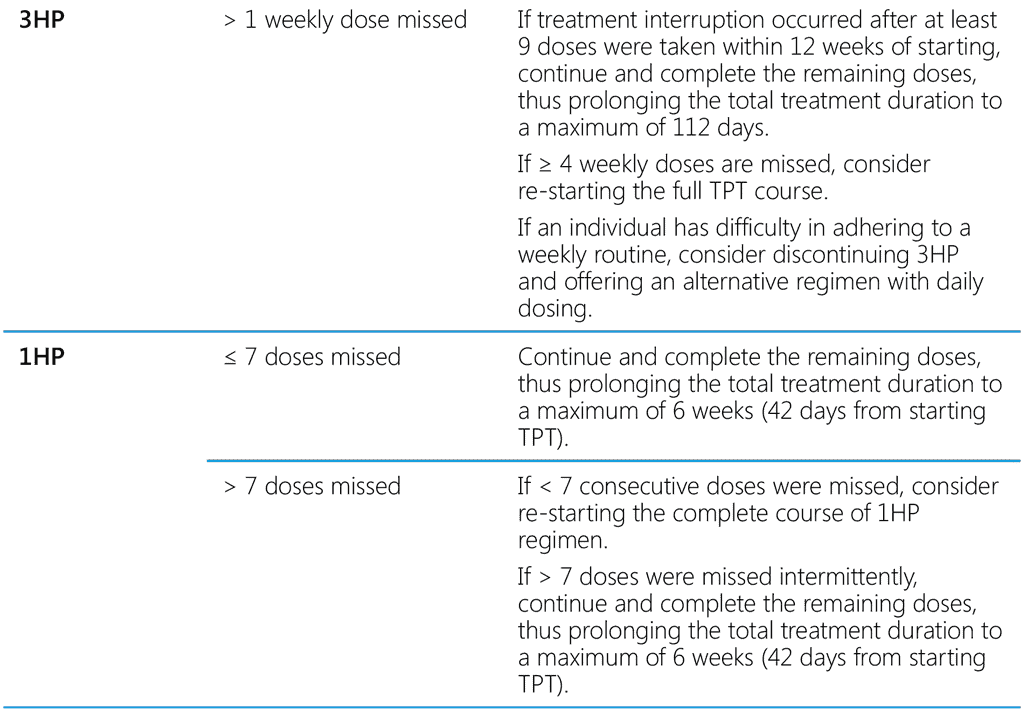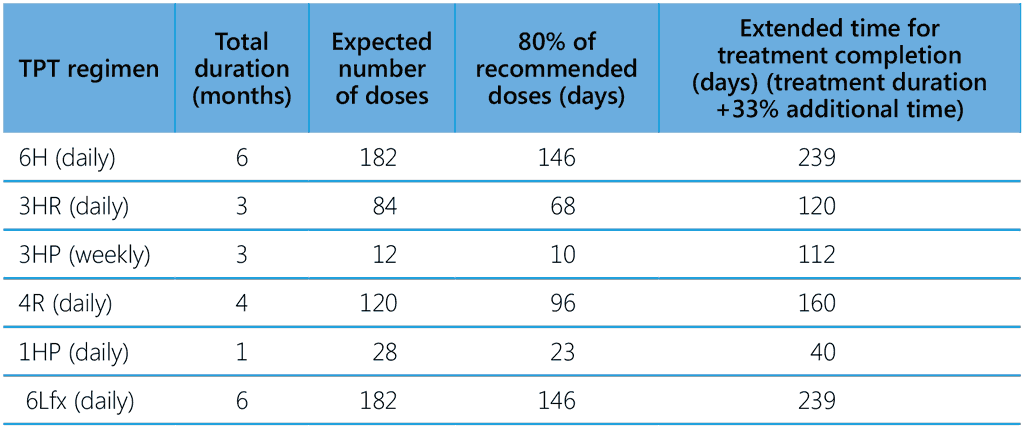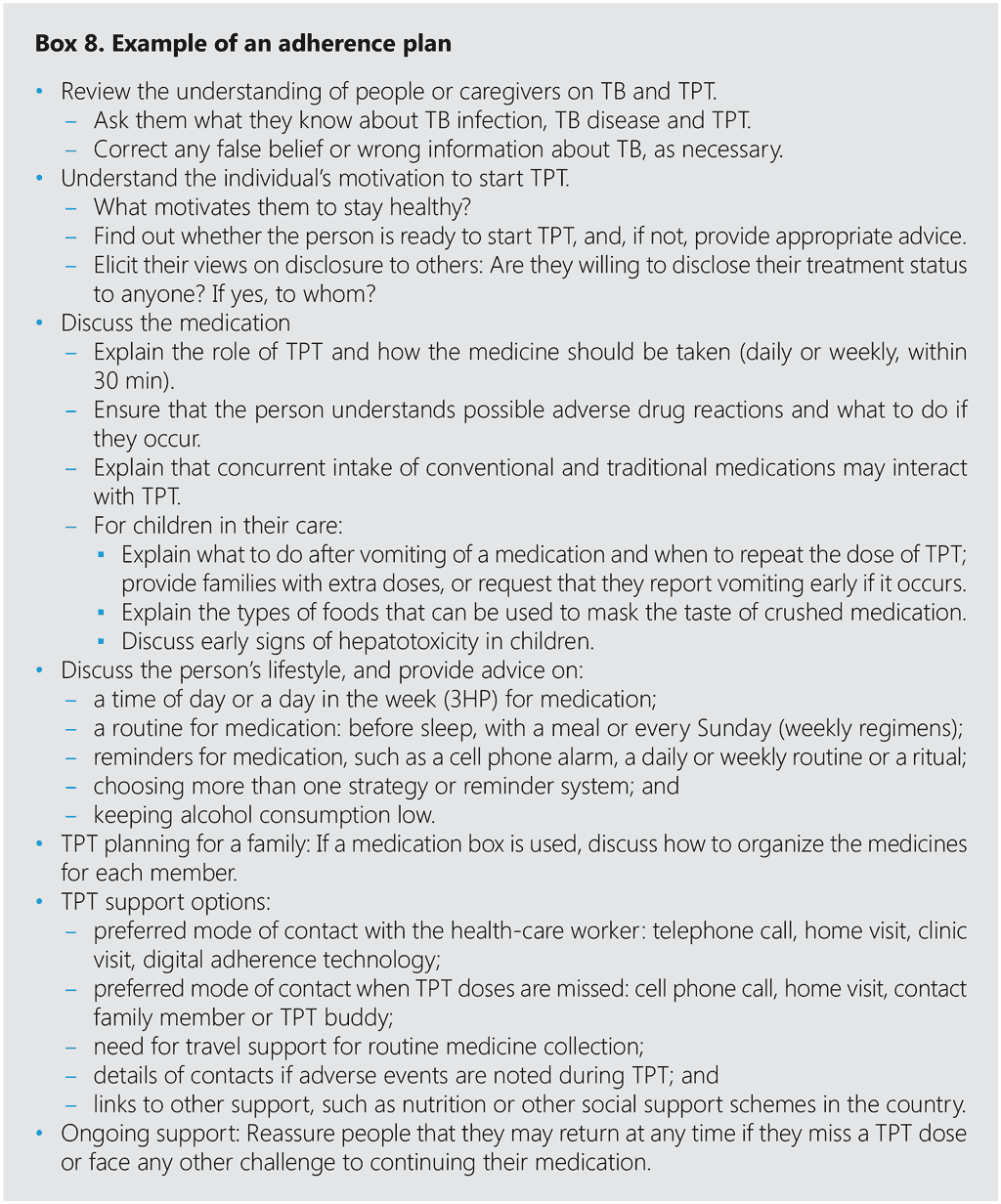Links de passagem do livro para 7.1 Monitoring TPT
Individuals receiving TPT should be monitored at every contact with health-care providers. It is important to determine non-adherence as early as possible in order to take corrective action. Monitoring is particularly important at the beginning of treatment, when people are getting used to the routine and their medication. Afterwards, monitoring may be done monthly or more frequently as required for care of people on TPT or as per national policy. Nurses and other front-line healthcare workers can be trained to monitor and to decide whether TPT should be changed because of adverse events or be re-started (e.g. after an interruption of treatment). Medical doctors or specialists are not required for such decisions, but their services should be available when required.
Alternatively, monitoring may be aligned with mechanisms in the DSD model for people with HIV, where implemented, or in a schedule for collection of other medication at a health facility (see also section 5). On principle, the schedule for follow-up visits or drug collection should be at the individual’s convenience. It is important that an informed decision by a person offered TPT not to take the treatment or to stop it after having started it be respected; people should not feel coerced to take treatment. (See also ethical principles in section 9.)
7.2 Management of missed doses
When people interrupt TPT, it is important to identify the reasons for the interruption. The person taking TPT and their caregiver should be counselled on the importance of adherence, and the healthcare worker, with the person taking TPT and their caregiver, should review ways to improve adherence and agree on a way forward. There is little evidence on how many missed doses can be made up for by prolonging treatment without compromising efficacy. Table 8 proposes means to manage interruptions in TPT, depending on the duration of non-adherence and the TPT regimen.
Table 8. Management of interruptions by duration for different TPT regimens


1HP, 1 month of daily rifapentine plus isoniazid; 3HP, 3 months of weekly rifapentine plus isoniazid; 3HR, 3 months of daily rifampicin plus isoniazid; 4R, 4 months of daily rifampicin monotherapy; 6H, 6 months of daily isoniazid monotherapy; 6Lfx, 6 months of daily levofloxacin monotherapy; TPT, TB preventive treatment.
Interruptions may be consecutive or intermittent, unless otherwise indicated.
7.3 Determining TPT completion
The proportion of expected doses taken within the usual duration of the regimen and the total number of doses taken are considered to be key determinants of the efficacy of TPT (116,117). Various endpoints have been used in trials to determine TPT completion, such as 80% of the doses consumed within 120% of the planned TPT duration (165) and 90% of recommended doses consumed within 133% of the planned TPT duration (166). The V-QUIN trial of 6Lfx considered a contact to have completed the study therapy if they completed ≥ 80% of the total number of prescribed doses within a total of 30 weeks after randomization (167). In this handbook, we propose that programmes declare TPT to be completed when at least 80% of the expected doses are taken within the usual duration of the regimen and the remainder taken within an extended time equivalent to one third of the usual duration. Table 9 shows how these timings apply to all recommended regimens. The limits shown in this table are meant to guide classification of TPT completion; other considerations may apply for decisions on continuing or re-starting of TPT after an interruption (see Table 8).
Table 9. Criteria for determining completion of different TPT regimens

In addition to the indicators for monitoring PMTPT proposed in section 8, programmes may wish to consider unfavourable end-points of TPT for triggering a review of case management and, in some instances, changes to medication:
- failed: development of TB disease any time while on TPT;
- died: death from any cause while on TPT;
- lost to follow-up: interruption of TPT for a duration that precludes completion of treatment in the maximal time possible (at thresholds shown in Table 9);
- TPT discontinued by a health-care worker: due to toxicity, other adverse events or drug–drug interactions, with or without re-starting or switching the regimen; and
- not evaluated: such as records lost, transfer to another health facility with record of TPT completion.
7.4 Potential barriers to adherence
Many factors may influence a person’s decision to adhere to or interrupt a recommended treatment regimen. Non-adherence should be recognized and addressed as soon as possible. The following should be considered potential barriers to adherence to TPT among adults:
- competing priorities, such as work, travel, school, caring for children or the elderly;
- little conviction of the importance of TPT (TPT considered more of a nuisance than of use);
- treatment-related issues:
- understanding how to take or administer TPT correctly and its duration;
- adverse drug reactions associated with the medicines and personal history of reactions to medicines;
- coexisting medical conditions;
- onset or possibility of pregnancy;
- concomitant use of other medicines, conventional or otherwise, or food supplements that could interfere with adherence to or the effectiveness of TPT medicines (e.g. oral contraceptives, ARVs);
- alcohol intake during medication;
- difficulty in remembering daily or weekly doses; and
- religious practices such as fasting;
- health-care service issues: cost of clinic visits (transport, time, loss of work), clinic opening hours, conflict with a person’s schedule, long waiting times at clinics;
- incorrect or insufficient information about TB infection and TB disease;
- real or perceived stigmatization of people with TB infection, disease and treatment; and
- health beliefs and practices.
7.5 Strategies to improve adherence and treatment completion
7.5.1 Supportive measures
National programmes should have mechanisms to improve adherence of specific risk groups in the local context. In general, all TPT options can be self-administered. Appropriate scaling-up of TPT is unlikely to increase the selection of drug-resistant TB strains. Modalities for treatment provision and adherence support should be determined primarily by the individual. Although several methods have been used to improve treatment adherence and completion, the evidence for their effectiveness remains inconclusive (168). Pill counting by providers at every contact with a person on TPT is inexpensive and feasible and was association with a reduction in the risk for TB in a clinical trial (117). This practice can easily be included into TPT services. Adoption of blister-packaged products rather than pill bottles might also facilitate monitoring of adherence.
WHO guidelines for treatment, care and support propose several interventions for supporting adherence (169), which could also be applied to TPT. They include peer support networks, coaching and educational interventions, including counselling, use of electronic medication monitors and videosupported treatment. National programmes should dedicate the necessary financial and human resources to strengthening adherence to TPT and not allow concern about adherence or lack of tools for adherence to be a barrier to scaling up TPT services.
Acceptance of TPT by a person at risk is often influenced by information given by counsellors, nurses, doctors, pharmacists and other health-care staff. So that people can fully appreciate the rationale of TPT, the following benefits should be explained.
- TPT can prevent TB disease from occurring later. TB disease can lead to a long period of severe illness, permanent damage to organs and premature death if untreated.
- It is particularly important for people who have the following conditions to take TPT to reduce their risk of developing TB disease:
- people with recent TB infection;
- contacts of people with TB disease, especially children aged < 5 years;
- people with HIV and other medical conditions that lower their immunity; and
- people taking medication that lowers their immunity, such as anti-TNF and steroids.
- TPT with new medicines that shorten the treatment duration to ≤ 3 months is now recommended by WHO, whereas TB disease requires ≤ 4–6 months of treatment, starting with four medicines.
Providers should also alert people about TPT-related adverse drug reactions and the likelihood of their occurrence (see section 6). Red discolouration of urine and other body fluids while taking 3HR, 3HP, 1HP or 4R is normal and is harmless and reversible.
7.5.2 Providing guidance to individuals receiving TPT
Interventions to ensure adherence and treatment completion should be tailored to the needs of each risk group and the local context. It should be emphasized that protection from TB by a course of TPT depends on the degree of adherence, although concern about perfect adherence should not be a barrier. The 2022 WHO guidelines on TB care and support propose digital and other interventions to support adherence by people on treatment for TB disease, which could also be used for TPT (169). Similarly, best practices for the care of TB patients include considerations that could be used for TPT (170).
The following should be considered when providing guidance to individuals receiving TPT.
- Ensure that the person prescribed TPT is committed to taking it properly and understands the importance of adherence and completion of treatment for maximum protection. Provide information in the first language and at the appropriate literacy level of the person concerned.
- Explore the person’s understanding of TB and TPT, and elicit support from family members or a companion in a similar situation (“treatment buddy”).
- Explain the importance of taking treatment on a fixed schedule, which makes it easier to remember to take the medication. A time of the day could be fixed for daily regimens and a time and day of the week for 3HP.
- Offer reminders and suggestions to help take medication regularly, including
- electronic reminders on cell phones: bidirectional SMS and voice calls can improve communication with the caregiver, such as on suspected toxicity; or
- a suggestion to take the medication with a specific meal or before sleeping (daily) or at the time of recurring activities, such as Friday, Saturday or Sunday prayers (weekly). (A television or radio programme should not be recommended as a reminder as it may be rescheduled or moved to a different time slot or there may be an electricity outage.)
- Explain that all medications should be taken together and the dose not be divided over a few hours or days. Pills can be taken separately, provided that the whole dose is taken within 30 min.
- Explain the importance of completing the full course of treatment for optimal protection from TB.
- Give clear information about adverse drug reactions (“side-effects”) and signs that treatment should be stopped and a health-care worker contacted. Stress the importance of informing and seeking care from the provider in case of an adverse drug reaction, even if it is mild. In most cases, treatment of symptoms will suffice without having to stop or defer TPT.
- Involve family members and caregivers in health education when possible. Children often move between households and health facilities, and additional facility members and caregivers could also be involved in support for adherence.
- Seek agreement with the person on TPT and their family, caregiver or health worker on a personal adherence plan, aligned to the treatment regimen. Box 8 shows an example of a plan that could be adapted to each context. Informative materials (leaflets, posters, video clips) could be developed to reinforce messages.
At each contact with the person receiving TPT, the provider should:
- reinforce the person’s understanding of symptoms of TB disease, reasons for TPT and the importance of completing the course;
- discuss the points on the adherence plan with the person on TPT at each visit, including the motivation of the person to remain TB free and strategies to optimize the best time to take the medicines;
- reinforce supportive educational messages at each contact during treatment;
- invite questions, provide clear, simple answers, and provide a telephone number for other queries or advice from health services;
- measure body weight, and adjust the TPT dosage accordingly, particularly for young children, as rapid weight gain is normal in growing infants and young children, thus requiring dosage adjustment;
- check for the presence of signs or symptoms of TB disease;
- ask about any adverse drug reactions, and manage any toxicity or refer to specialist care if necessary;
- elicit reasons for any missed dose, and extend the necessary support for adherence;
- continue management of comorbidities, and consult the treating doctor when necessary;
- ask about pregnancy, breastfeeding and contraceptive use;
- make a record of the visit, drug intake and findings from individual case files or forms prescribed by the national programme; and
- ensure confidentiality in all exchanges with the person on TPT and their entourage.

7.5.3 Creating an empowering environment to improve adherence
In addition to counselling people taking TPT and their families, the environment of the person on TPT should enhance the treatment experience.
- Align TPT delivery and follow-up with HIV or other services that the person may be receiving, including use of DSD models, and organize motivational counselling by trained providers.
- Identify an appropriate treatment supporter, such as a family member, neighbour or colleague. The treatment supporter should be counselled on providing care and support. Record the contact details (home address, home and work phone numbers, mobile phone number, e-mail address) of the treatment supporter to minimize the risk of losing contact. It is important to maintain the confidentiality of this information.
- Schedule in-person meetings for individuals whose treatment has been interrupted or who missed appointments for medication refills. Digital adherence technologies, such as electronic medical monitors (pill boxes equipped with SIM cards) and video-supported therapy may help to ensure adherence when in-person visits are not feasible.
- If possible, encourage or motivate individuals, depending on the country context and availability of funds. Some countries provide mobile phone credit (“airtime”), grocery shop coupons or food parcels. While these are common, their role in improving adherence has not been clearly demonstrated (171).
- Provide incentives such as reimbursement of transport cost and phone calls to facilitate keeping appointments, depending on the availability of funds.
People on TPT should be seen by health-care workers at scheduled intervals appropriate to the country (every 2 weeks, monthly, quarterly). These encounters may take place in a clinic, in the community or in the household and serve to dispense medicines, assess progress and update records. Each such contact is an opportunity:
- to ask the individual about adherence and strategies used to ensure adherence (Show that you are also interested in helping them to adhere to treatment; discuss how many daily or weekly doses have been missed and how this can be avoided.);
- for adherence counselling, by
- discussing any barriers and proposing joint solutions and
- using motivational interviewing techniques to improve adherence (172) (“How do you feel when you have missed a dose?” “How do you want to change that?”);
- for checking used blister packs and counting the remaining pills to determine whether the pill count corresponds to the expected consumption during the interval;
- to ask specifically about adverse events and TB symptoms;
- to check contact information against clinic records, including one verified cell phone number and the number of a close contact person; and
- to update the monitoring system and flag any person who misses a visit for a follow-up call within 1 week of missing the scheduled clinic visit, to enquire:
- about adverse events, TB symptoms, pregnancy;
- whether the person still has medicines; and
- agree on the next clinic appointment as soon as possible.
7.5.4 Special considerations for adherence by children
As infants and children depend on caregivers for administration of medication, the barriers faced by their adult caregivers can result in missed doses for children. Other barriers that may apply include:
- lack of child-friendly, dispersible, palatable medication, which is easier to administer to children than solid tablets or even crushed pills dispersed in water;
- lack of conviction by the caregiver about the importance of TPT. Only if both caregivers and healthcare workers are invested in successful completion of TPT will it be possible for the child to adhere to TPT;
- lack of one or more appropriate caregivers among relatives, as young children may move among different houses in the family; involvement of several caregivers (grandparents, father’s family) may be necessary;
- lack of knowledge of caregivers about TB and TPT;
- changes in the routine of the family or child (such as school holidays) that disrupt the administration schedule; and
- lack of acceptance of the authority of a caregiver by older and more mature children and adolescents.
Strategies for managing and enhancing adherence among children are similar to those discussed above.
- Explain and emphasize to the caregiver and child why they must take the full course of TPT.
- Inform them about the availability of child-friendly formulations, and provide clear explanations and instructions to caregivers on dissolving dispersible tablets in water. Illustrative posters, handouts and videos may help.
- Provide a person-friendly schedule for appointments for drug refills.
- Take note of the reasons for poor adherence, and attempt to address them: such as long-distance transport, orphans, previous adverse reactions to medicines or the ill health of the primary caregiver.
- Provide adolescents directly with education and adherence support, especially if they are living with HIV.
- For young children who refuse to take medicine:
- change the food type to better mask the taste, or place crushed medicines in the centre of solid food that is easy to swallow as alternatives to mixing with water; or
- provide a small reward for taking medication completely.
- change the food type to better mask the taste, or place crushed medicines in the centre of solid food that is easy to swallow as alternatives to mixing with water; or
- If a child vomits within 30 min of a dose, ensure that a new dose is given. Families should therefore be given a few extra doses every month. (The programme should estimate the extent of such losses and reflect it in procurement plans.)
- Prepare an adherence plan with the caregiver and ask that it be shared with other caregivers.
- Review the adherence plan at each encounter, especially if a new caregiver is present.
- Review the knowledge and barriers of the caregiver at each visit. Examples of questions to be asked are:
- Who is the primary caregiver (parent, grandparent, aunt, uncle, another child)?
- Does the child sometimes sleep in another family member’s house?
- Is the caregiver aware that the treatment is daily (isoniazid, 3HR) or weekly (3HP) for 3–6 months?
- Is the caregiver aware of the number of pills to be given each time?
- Is the caregiver aware of the procedure for administering child-friendly dispersible formulations?
- Has the caregiver been counselled about the importance of adherence, adverse drug reactions, when to seek a health-care worker’s advice and what to do when the child vomits medication?
 Opinião
Opinião